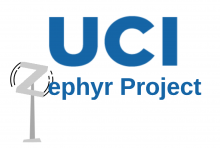UCI Zephyr Project
Background
Wind turbines have increased in popularity due to being a sustainable and renewable resource. Wind turbines use wind energy to make electricity. The wind turns turbine blades around a rotor spinning a generator that creates electricity. The electricity is stored in lithium-ion batteries or sent to the power grid to be used. The use of wind energy allows for less greenhouse gas emissions such as carbon dioxide to be released into the atmosphere, combating climate change.
UCI Zephyr Project is a senior design project tasked with creating a portable wind turbine to be used for personal use such as camping or hiking. We plan to create a small and compact wind turbine that can fit in a hiking backpack per the sponsor’s specifications. Such a device would be able to be quickly assembled and provide enough power to charge several small electronic devices overnight. The portable wind turbine uses a horizontal blade design to allow wind to create energy through a brushless direct current generator.
Goal and Objectives
The overall goal of this project is to design a portable wind turbine to charge small appliances. The team is aiming to complete a detailed design and manufacturing plan by the end of the quarter. The results will be presented at the Spring Design Review at the end of Week 10.
Technical Details - Sizing a Wind Turbine
Currently, wind turbines can be generally categorized into two main sections: horizontal axis (HAWT) and vertical axis (VAWT) wind turbines. HAWT are turbines in which the axis of rotation is parallel to the ground while VAWT axis of rotation is perpendicular to the ground. When deciding between what type of turbine to choose for our needs, we calculated the power generated by each type for comparison.
Efficiency for a HAWT is around 40%-50% while a VAWT is around 30%-40%. Area for a HAWT is dependent on the radius of the blades while the VAWT depends on radius and height of the overall blades. Reference dimensions were where radius for both turbines was 1 ft and the height for the VAWT was 1 ft. After calculating the power for each type of turbine, the HAWT produced ~2.5 times the power that the VAWT produced. For the VAWT to produce the same amount of power the HAWT does at the reference dimensions, the radius and height of the VAWT would have to be doubled. The results of this analysis led to the decision to go with a horizontal wind turbine design.
Progress
The team completed the detailed design, prototype plan, and performance simulations. The result is a portable HAWT that weighs 8lbs, fits within a medium sized hiking backpack, and is capable of producing 10W in wind speeds of 11mph. The wind turbine can reach up to 35W in wind speeds of 26mph. Due to a majority of the team graduating this quarter, the project has no immediate future plans.
Team Contact
Nausir Firas nfiras@uci.edu
Project Sponsor
Moatasem Fouda mafouda@uci.edu

